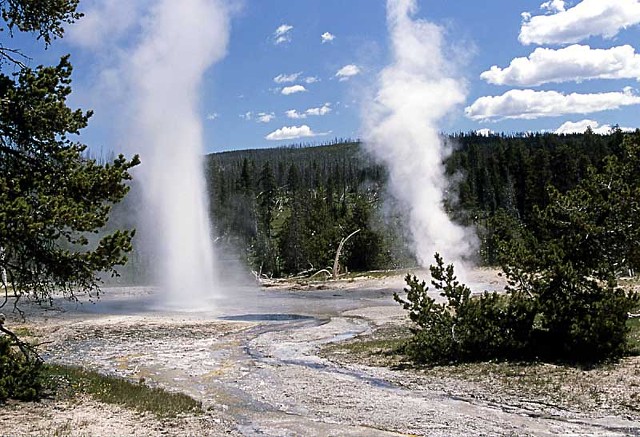작성자 : p1111
추천 : 6
조회수 : 7355회
댓글수 : 7개
등록시간 : 2014/04/02 11:08:57
| WORRY: More Unusual "Activity" at Yellowstone Super Volcano |
| Wednesday, 19 February 2014 21:45 옐로우스톤 수퍼 화산에 우려할 만한 상황이 일어나고 있다. 다른 화산들이 폭발하기 직전에 보이던 현상이다. 지표면이 솟아오르고 균열이 생기는 것뿐 아니라 헬륨-4라고 불리는 매우 드문 형태의 가스가 표면에서 나오기 시작했다. 과학자들이 상당히 우려하는 부분이 바로 이것이다. 만약 옐로우스톤이 폭발한다면 1980년 세인트헬렌 화산 폭발의 2,000배 이상의 규모일 것이며 500마일 이내의 모든 것이 몇 분만에 죽거나 파괴된다. 미국의 2/3가 화산재로 뒤덮힐 것이고 전 세계의 기후가 몇 달 동안 낮아질 것이다. (농작물이 제대로 성장하지 못해 극심한 기근이 예상된다. : 역자 주) 무엇보다, 지난 주에 미국에서 가장 강력한 지진이 옐로우스톤으로부터 몇 마일 떨어진 곳에서 발생했다. 이는 뜨거운 마그마가 움직이고 있다는 증거다. |
| February 19, 2014 -- (TRN) -- Some worrying developments are taking place at the Super Volcano located beneath Yellowstone National Park; the kind of developments that were seen shortly before other volcanoes erupted. Not only was there a sudden rise in the elevation of the ground, and development of new cracks, but a gas called Helium-4, a very rare type of Helium, has begun coming out of the surface. It is the presence of this gas that has scientists quite concerned. If the Yellowstone Super Volcano were to erupt, it would be 2,000 times bigger than the eruption of Mount St. Helens in the 1980's. Everything within 500 miles would be dead or destroyed within minutes, 2/3rds of the entire United States would be covered in volcanic ash and the climate of the entire planet would cool within a month. On top of that, just this past week, the largest earthquake in the US took place just a few miles from Yellowstone proving hot magma is on the move. Here's what has scientists concerned: Since late summer 2013, the Yellowstone GPS network has tracked a small " ground deformation episode" in north-central Yellowstone National Park. During the past five months, the NRWY GPS station has recorded about 3.5 cm (1.4 in) of uplift(the ground is rising) and about 1 cm (0.4 in) of southeastward ground movement, relative to a stable reference station north of the Park. Measurements from other GPS stations in northern Yellowstone show smaller displacements, forming a circular pattern of deformation (circular -- as in the round mouth of a volcano) consistent with a minor pressurization (building-up underground), about 6 to 10 km (4-6 miles) deep, near Norris Junction. 과학자들이 매우 우려하는 것은 옐로우스톤이 엄청난 양의 헬륨-4를 분출하기 시작했다는 것이다. 헬륨4는 화산 폭발 직전에 분출되는 것으로 판단되며, 다른 화산 폭발의 예에서 증명되었다. What has scientists very concerned is that Yellowstone has suddenly begun emitting massive amounts of Helium-4. Helium-4 seems to be the predictor of activity, as proved with other volcanos. For instance, as the volcanic island of El Hierro, the smallest of Spain's Canary Islands, rumbled and groaned over the course of seven months in 2011 and 2012, gases silently percolated up through the island's soil and groundwater. Eventually, a spectacular plume appeared off the southern coast of the island, a sign that El Hierro volcano, an underwater volcano just offshore, had finally erupted. The team's analyses show that, as the El Hierro volcano began to stir, the crust fractured and helium, mostly from the mantle, flowed to the surface. As the actual eruption began, gas flow at the surface increased dramatically, and gas pressure beneath the island dropped. Then as seismic activity at El Hierro picked up again, the crust fractured and deformed extensively, and helium-4 became a larger component of the total helium released on the island. Looking at the past ratios of helium at Yellowstone 1978: Helium isotope ratios (³He/4He) in Lassen Park and Yellowstone Park volcanic gases show large ³He enrichments relative to atmospheric and crustal helium indicating the presence of a dominant mantle-helium component. Study released today on Yellowstone helium: The scientists who revealed today's information report the quantity of helium-4 in Yellowstone's gas emissions is hundreds to thousands of times greater than it should be — a sign that the crust is releasing its ancient stores of the rare isotope, the researchers said."However, much of the helium emitted from this region is actually radiogenic helium-4 produced within the crust by decay of uranium and thorium. Today's report shows by combining gas emission rates with chemistry and isotopic analyses, that crustalhelium-4 emission rates from Yellowstone exceed (by orders of magnitude) any conceivable rate of generation within the crust." This means the Helium -4 is coming from very far beneath the ground, a clear signal that something big is happening that hasn't happened in Yellowstone in our lifetime. LATimes: In areas where there is little groundwater or movement in Earth's crust, helium-4 can remain trapped and build up over time. This is especially true at Yellowstone, where inactive rocks, or what geologists call "craton," have been estimated to be 2.5 billion years old. (The park is located primarily in Wyoming.) Things began to change roughly 2 million years ago, however, when hot magma intruded on the crustal system from below and triggered several enormous volcanic eruptions, the most recent about 640,000 years ago. For scientists, there are important implications to the recent developments at Yellowstone. Helium and other noble gases are used to estimate groundwater residence times—for example, scientists assume that the more helium-4 present in water, the longer that water has been sitting in the rocks surrounding it. But the study of helium at Yellowstone shows that some of these assumptions—specifically helium-4 produced by the steady decay of elements found only within the rocks and sediments of the local aquifer — aren’t quite right. Helium can suddenly come into a system from unexpected places—a pocket of ancient rock, for instance, or a magma source — so the dates in past calculations, particularly those from aquifers in volcanic regions or near earthquake faults, might be way off because of that extra helium. Scientists, though, are used to dealing with new data that changes long-held theories; that’s the nature of science, after all. One of the largest earthquakes in the US this week, at just M3.6, occurred close to Yellowstone crater, on 11 February. The area, which overlies a hotspot (where hot magma from the mantle rises to the surface) is characterized by frequent earth tremors, which often occur in clusters (or ‘swarms’) such as those of 2004, 2009 and 2010. Tectonically speaking, Yellowstone lies to the east of most of the major earthquake zones which characterize western North America and the earthquake swarms around Yellowstone are related to movements of the magma which lies beneath. Residents of the Yellowstone area, however, probably wish researchers would just hurry up and figure out whether or not the supervolcano that’s simmering below them and last erupted 640,000 years ago is going to blow again anytime soon. WHAT TO TAKE AWAY FROM THIS NEWS 1) The ground inside the gigantic mouth of the Yellowstone Super Volcano is rising and moving southeastward. 2) Helium -4, not normally present, has suddenly appeared at Yellowstone in unbelievably large amounts never seen before. 3) When Helium -4 was seen at other volcanoes, it appeared shortly before major eruptions of those volcanoes. 4) Prior to most volcanic eruptions, earthquakes occur near the volcano and just this past week, one of the largest earthquakes in the US at just M3.6, occurred close to Yellowstone crater, on 11 February. Naysayers beware, the evidence is stacking up. if you're waiting for an mass-media announcement....it has now happened and wont get any more direct. These words don't come lightly from experts who appreciate that such statements - if wrong - can undermine the jobs these scientists do. We have previously (within the last week) been warned an eruption could occur suddenly with no warning....that was the warning! All those living locally should not expect anything more but the evidence above!! |




